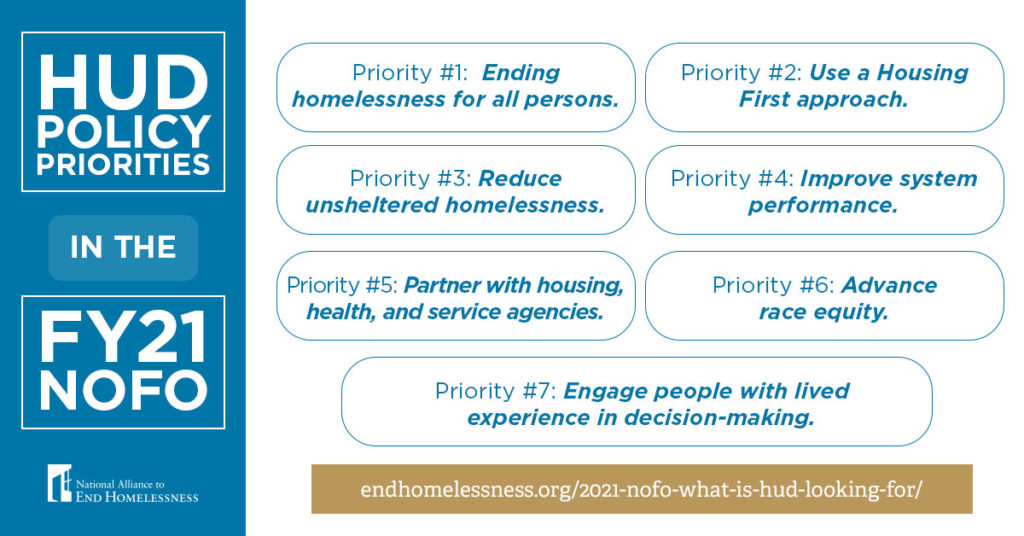Such an analysis should influence how localities approach the new HUD Notice of Funding Opportunity (NOFO). Analyzing systems can help communities identify key priority areas for improvement to meet their own goals of helping people quickly exit homelessness safely and efficiently.
Ideally, local leaders will find that their local goals align with HUD’s priorities, which are oriented toward improving how systems function to assist people experiencing homelessness.

Here are some examples of questions about your system that you should take into consideration to advance your own performance and adhere to HUD’s specific policy priorities in the NOFO:
- Is your system attending to the needs and outcomes of all people experiencing homelessness or just focused on one or two subpopulations?
- Are data being captured and examined to identify those with the highest needs and longest experiences of homelessness to ensure they are connected to housing and services that will help them exit homelessness?
- Is information being collected as to needs and outcomes of all subpopulations so performance can be regularly assessed, improvements made, and new partnerships crafted to meet people’s needs?
- What steps can you do to improve your system’s performance to end homelessness for all persons?
- Is your system moving people quickly and effectively to permanent housing?
- Are some organizations funded in your system “Housing First” in name only and failing to adhere to its principles? What will you do to ensure that all funding organization are truly “housing first?”
- Do you have sufficient investment in landlord engagement and recruitment?
- What investments must be made and/or scaled up with new resources to improve performance?
- Are there efforts in your locality to end unsheltered homelessness or just to manage it? Are people being identified, outreached, and assisted to find permanent housing options or are they simply being policed and monitored?
- Are unsheltered individuals being prioritized for Continuum of Care (CoC) funded projects as well as other external funding resources, including the Emergency Housing Vouchers?
- Are significant resources being deployed to assist them or largely to programs they will never benefit from?
- How can you use the NOFO and other new federal funding streams to reduce unsheltered homelessness? How can you demonstrate significant meaningful investment toward attaining this goal?
HUD acknowledges the impact of the COVID-19 pandemic on system data quality and performance. While this will be taken into consideration this year, the NOFO cautions CoCs that system performance will become an increasingly important part of how their application is scored from 2022 and onward.
- How good is your locality’s data? Are you using your system measures to make funding decisions?
- Are you analyzing your data at least quarterly to identify where your system and individual programs are achieving strong outcomes and where they are falling short? Are you ensuring this data is informing your ranking and prioritization process?
- Is your Coordinated Entry System facilitating and expediting access to assistance for all persons (and to a wide range of services) or has it become a speed bump to aid, creating delays?
- How can it be improved so people have greater trust in the process and more choice?
- What shifts can you make with new funds to improve system performance?
Completing the NOFO in a Time of Stress Responding to the NOFO is overwhelming and it comes at a time when homeless service system staff are tired and depleted. There is so much to do and there has been little respite over the last year and a half. Unfortunately, it doesn’t even seem as if the end is in sight. Please take care of yourself, your loved ones and your colleagues. Thank you for everything you do to meet the needs of people experiencing homelessness every day. When you can, carve out time to think strategically about the NOFO. How can you advance your system through the NOFO process to adhere to your own goals, and make progress toward achieving HUD’s vision identifiable through the outlined priority areas? Think about where these investments are critically needed in your community. These are hard choices to make, but they hopefully will ease the burden on you, your colleagues, your workforce – but more importantly, will enable more people exit homelessness and achieve safe permanent housing.

